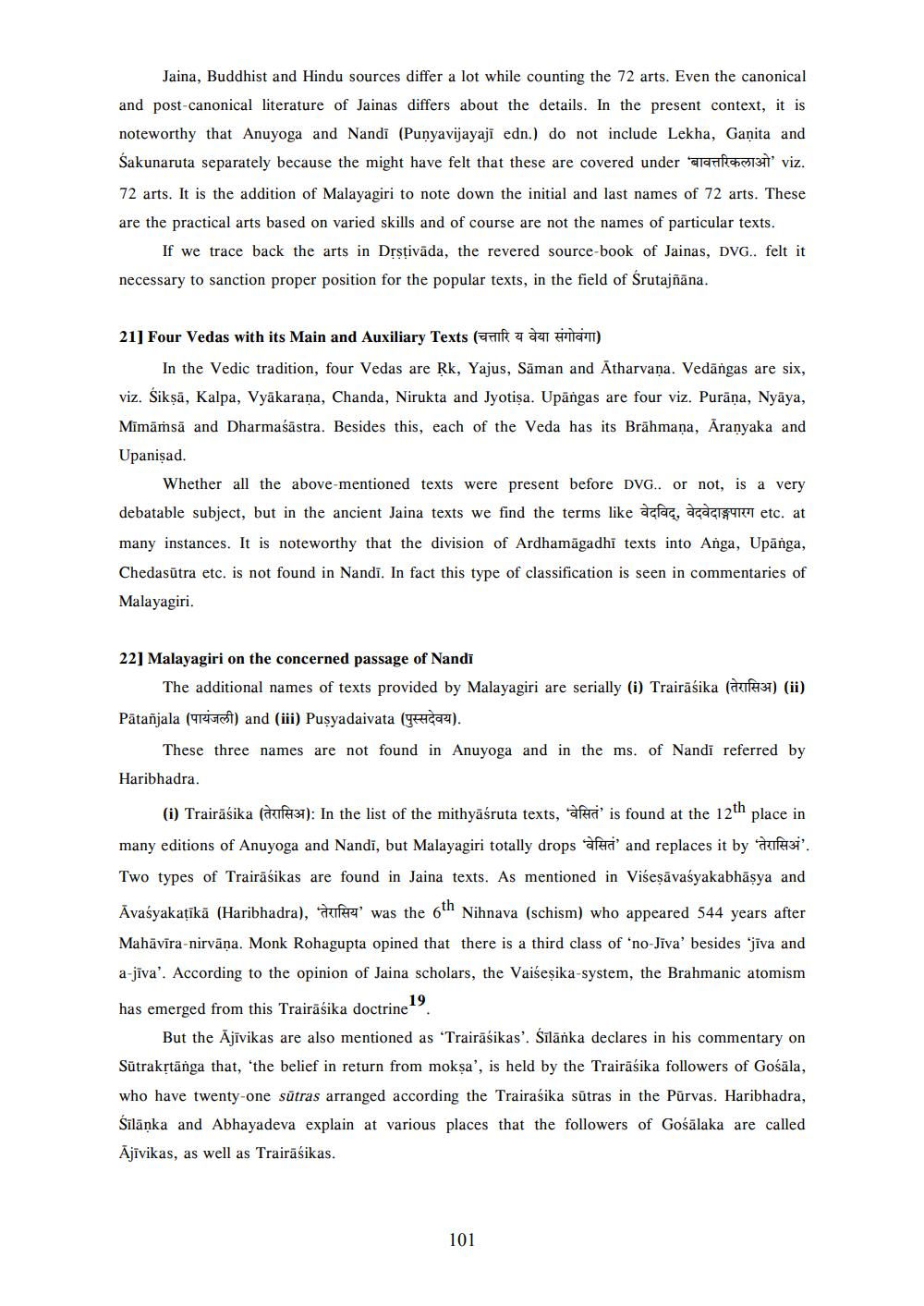________________
Jaina, Buddhist and Hindu sources differ a lot while counting the 72 arts. Even the canonical and post-canonical literature of Jainas differs about the details. In the present context, it is noteworthy that Anuyoga and Nandi (Punyavijayaji edn.) do not include Lekha, Ganita and Sakunaruta separately because the might have felt that these are covered under alcacho131 viz. 72 arts. It is the addition of Malayagiri to note down the initial and last names of 72 arts. These are the practical arts based on varied skills and of course are not the names of particular texts.
If we trace back the arts in Drstivāda, the revered source-book of Jainas, DVG.. felt it necessary to sanction proper position for the popular texts, in the field of Srutajñāna.
21] Four Vedas with its Main and Auxiliary Texts (auf der Ham)
In the Vedic tradition, four Vedas are Rk, Yajus, Sāman and Atharvana. Vedāngas are six, viz. Sikṣā, Kalpa, Vyākarana, Chanda, Nirukta and Jyotisa. Upāngas are four viz. Purāna, Nyāya, Mimāmsā and Dharmaśāstra. Besides this, each of the Veda has its Brāhmaṇa, Aranyaka and Upanişad.
Whether all the above-mentioned texts were present before DVG.. or not, is a very debatable subject, but in the ancient Jaina texts we find the terms like acfag, aagiskt etc. at many instances. It is noteworthy that the division of Ardhamāgadhi texts into Anga, Upānga, Chedasūtra etc. is not found in Nandi. In fact this type of classification is seen in commentaries of Malayagiri.
22] Malayagiri on the concerned passage of Nandi
The additional names of texts provided by Malayagiri are serially (i) Trairāśika ( 34) (ii) Patanjala (पायंजली) and (ii) Pusyadaivata (पुस्सदेवय).
These three names are not found in Anuyoga and in the ms. of Nandi referred by Haribhadra.
(i) Trairāśika (auf:31): In the list of the mithyāśruta texts, and is found at the 12th place in many editions of Anuyoga and Nandi, but Malayagiri totally drops and and replaces it by 31. Two types of Trairāśikas are found in Jaina texts. As mentioned in Višeşāvasyakabhāsya and
Āvaśyakațīkā (Haribhadra), VII was the 6th Nihnava (schism) who appeared 544 years after Mahāvīra-nirvāņa. Monk Rohagupta opined that there is a third class of 'no-Jiva' besides 'jīva and a-jīva'. According to the opinion of Jaina scholars, the Vaiseșika-system, the Brahmanic atomism
has emerged from this Trairāśika doctrine
But the Ājīvikas are also mentioned as "Trairāśikas'. Silānka declares in his commentary on Sūtrakrtānga that, 'the belief in return from mokşa', is held by the Trairāśika followers of Gośāla, who have twenty-one sūtras arranged according the Trairašika sūtras in the Pūrvas. Haribhadra, Śīlāņka and Abhayadeva explain at various places that the followers of Gośālaka are called Ājīvikas, as well as Trairāśikas.
101




